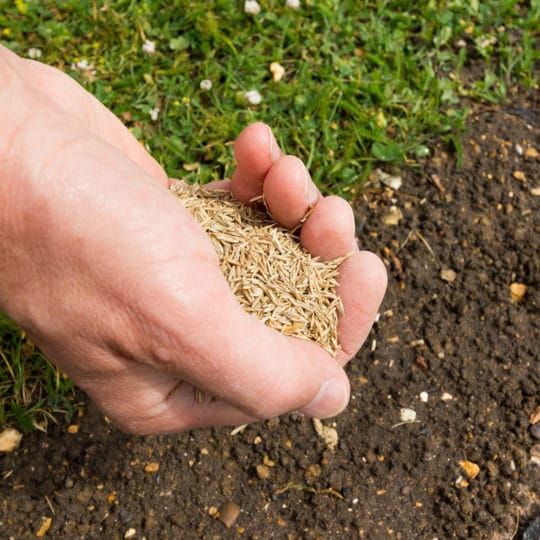Overseeding Your Lawn
When, Why & How
Posted
April 1, 2021

As your grass comes back to life in the spring, you may notice it’s looking thin and worn out already. If your yard is not bouncing back the way you’ve hoped it may benefit from overseeding. Follow these tips on the best time and process of overseeding your lawn.
What is Overseeding
To get your lawn looking lush, you have several options. One is overseeding, which is when you spread grass seed over your existing lawn to help thicken the thin areas. This is not to be confused with reseeding, which is when you have no lawn left and need to start over from soil. Whichever way you decide to reinvigorate your lawn, there’s still a specific time and process to follow for best results.
When Overseeding Your Lawn Works
Like all things lawn-related, timing depends on where you live and what type of grass you have. If you live in warmer climates and have warm-season grass, the best time for overseeding a lawn is late spring through mid-summer. The warmer soil temperatures help the seeds germinate before the weather gets too harsh.
Those who live in cooler climates should overseed their lawn in the fall. These grasses germinate better when the soil is still warm, the air is cool, and there are fewer weeds for new grass to compete against. However, if you’ve missed overseeding in the fall, spring is the next best season.
If your lawn is worn-out but you’re considering just leaving it as-is, consider this: unhealthy lawns attract weeds, pests, and disease. You may be dealing with more than just thin grass soon. Overseeding is a quick solution to help your grass bounce back. Plus, it saves you time from having to treat a larger problem or tear everything out and start again.
How Overseeding Your Lawn Works
Before your start spreading seed anywhere, review the steps to make the best out of your overseeding session.
- Choose the right seed. If you don’t know what type of grass you’re growing, ask a lawn and garden expert for recommendations. You’ll want to choose seed to match your existing grass type or at least one that thrives in your area. There are also overseeding products that contain seeds, fertilizer, and an element that helps improve the soil.
- Mow your lawn. Cut your grass a little shorter than normal, without scalping it, and bag the clippings. This will help the seeds reach the soil easier.
- To make it even easier, rake the lawn to remove any dead grass and debris. This also helps loosen the top layer of soil, giving the seeds an access route to root.
- If you’re using grass seed without any ingredients that help improve the soil, it wouldn’t hurt to rake a thick layer of enriched soil over your lawn to help the seed settle better. A thick layer will kill your existing grass, so go easy on this step.
- Now it’s time for seed. Use a seed spreader machine for a smooth, even layer.
- If you haven’t already used a fertilizing product, now’s the time to apply that to your newly overseeded lawn. Then top it with a light watering. You’ll want to keep the soil moist until the seedlings have reached the height of your existing grass.
Professional Lawn Maintenance
If after you’ve overseeded you still find your lawn isn’t looking its best, contact Cardinal Lawns for help. There may be a larger lawn issue that’s harder to diagnose right away. We can help get your grass back to beautiful so you can get back to enjoying it through the rest of the year.
Special Offer for New Customers
Two Free Lawn Care Treatments
Hurry! Offer Expires April 30, 2025